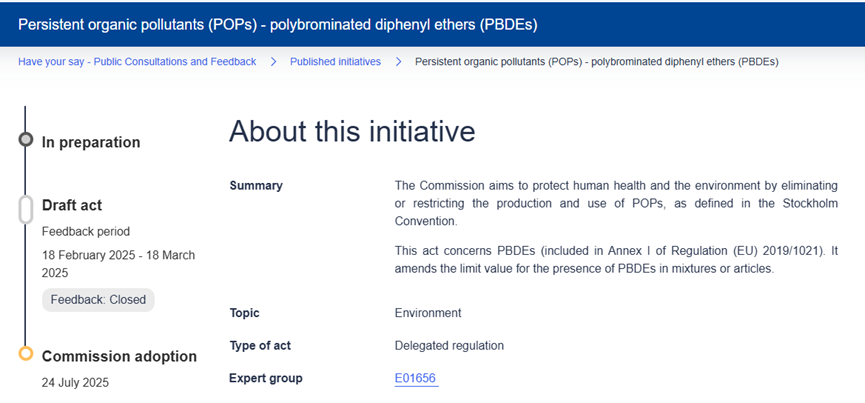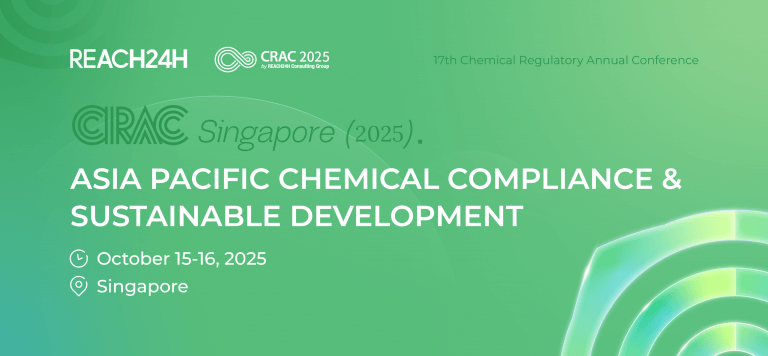News Brief
On July 24, 2025, the European Commission adopted a draft amendment to the POPs Regulation (EU) 2019/1021 concerning polybrominated diphenyl ethers (PBDEs). The next step is the publication of the formal revised regulation. This draft primarily lowers the control limits for PBDEs and sets phased deadlines, which will impact the chemical, recycling, and consumer goods industries.

This amendment, which will soon take effect, revises Annex I as follows:
| Substance | CAS No. | EC No. |
Tetrabromodiphenyl ether C12H6Br4O | 189084-62-6 189084-63-7 40088-47-9 93703-48-1 189084-61-5 | 620-888-9 621-541-4 254-787-2 621-837-3 621-543-5 |
Pentabromodiphenyl ether C12H5Br5O | 32534-81-9 189084-66-0 182346-21-0 | 251-084-2 620-889-4 621-547-7 |
Hexabromodiphenyl ether C12H4Br6O | 36483-60-0 182677-30-1 | 253-058-6 621-550-3 |
Heptabromodiphenyl ether C12H3Br7O | 68928-80-3 | 273-031-2 |
Decabromodiphenyl ether C12Br10O | 1163-19-5 | 214-604-9 |
Note: This table includes a selection of CAS and EC numbers for various PBDEs listed in the source document.
What are the Differences Between the Current Requirements and the Proposed Amendment?
Current Requirements
2. For the purposes of the entries on tetra-, penta-, hexa-, hepta- and decaBDE, point (b) of Article 4(1) shall apply to the sum of the concentration of those substances up to 500 mg/kg where they are present in mixtures or articles, subject to review and assessment by the Commission by 16 July 2021. This review shall assess, inter alia, all relevant impacts with regard to health and the environment.
Proposed Amendment
2. For the purposes of the entries on tetra-, penta-, hexa-, hepta- and decaBDE, point (b) of Article 4(1) shall apply to the following sum of the concentrations of those substances:
(a) 10 mg/kg upon entry into force of this Regulation where they are present in mixtures or articles, except for food contact materials subject to Regulation (EC) No 1935/2004;
(b) by way of derogation from point (a), 500 mg/kg upon entry into force of this Regulation, 350 mg/kg as of 30 December 2025 and 200 mg/kg as of 30 December 2027 where they are present in mixtures or articles containing or made of recovered material containing tetra-, penta-, hexa-,hepta- or decaBDE, except for food contact materials subject to Regulation (EC) No 1935/2004;
(c) by way of derogation from point (a), 500 mg/kg upon entry into force of this Regulation, 350 mg/kg as of 30 December 2025 and 10 mg/kg [OP please insert date: 18 months after entry into force], where they are present in toys subject to Directive 2009/48/EC, or in any product facilitating children’s seating, sleep, relaxation, hygiene, changing and general body care, feeding, sucking, transportation and protection, containing or made of recovered material containing tetra-, penta-, hexa-, hepta- or decaBDE, except for food contact materials subject to Regulation (EC) No 1935/2004’.
What are PBDEs?
PBDEs are toxic flame retardants that, despite being largely phased out, are still found in recycled materials. Decabromodiphenyl ether, the fully brominated product, has the lowest acute toxicity among all PBDEs and was therefore the most widely used globally in products like electronics, building materials, and textiles. Recent studies have shown the presence of decaBDE in consumer goods made from recycled plastics, highlighting the urgency of setting new limits.
This revision aims to promote ecological health and safer recycling practices, affecting multiple stakeholders. Recyclers and manufacturers using recycled plastics will need to update their screening processes and material sourcing specifications to ensure compliance. Producers of consumer goods, particularly in the toy and childcare sectors, will face stricter contaminant controls.
Relevant companies are advised to pay close attention to the evolving EU regulations on PBDEs, adjust their products destined for the EU, and prepare to meet their compliance obligations.





